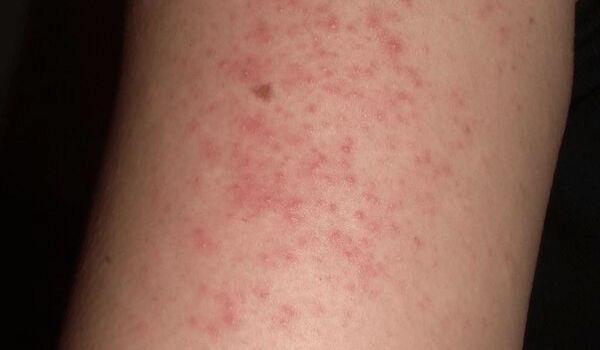What is keratosis pilaris? Keratosis pilaris is one of the most common pediatric skin conditions seen by dermatologists. The condition is caused by an excess of keratin. Keratin is a protein used to protect the skin from infections and other harmful things. The excess keratin plugs hair follicles, leading to sandpaper-like skin. The cause of keratin build-up is unknown. While keratosis pilaris is irritating, it is harmless.
Symptoms of Keratosis Pilaris
While keratosis pilaris is a common skin condition, it often goes undiagnosed due to the harmlessness of the symptoms. The most widely known symptom is small bumps that cause the skin to feel like sandpaper. The small bumps can appear in a variety of colors – including flesh colored, white, purplish, and brownish black. Does keratosis pilaris itch? It does, and in fact the second most common symptom is itchiness.
Keratosis pilaris is most often seen in children but can also be found in adults. In children, the small bumps can often be found on upper arms, the front of the thighs, and cheeks. In teens and adults, keratosis pilaris is often found on upper arms, the front of the thighs, and the buttocks. Some people may experience bumps on their lower legs and forearms.
Does Keratosis Pilaris Need Treatment?
Many people will try at home or over the counter treatments rather than see a dermatologist. But should you see a dermatologist? If keratosis pilaris is affecting your child’s life, then it is time to contact a dermatologist who specializes in pediatric dermatology. Dermatologists can help you create a treatment plan for your child and offer recommendations for reducing the symptoms.
The treatment plan can include options to reduce itchiness and dryness and diminish the appearance of bumps. We recommend moisturizers that include lactic acid or urea to help relieve the dryness and itchiness. You should apply the moisturizer to your child’s skin two or three times daily, especially after a shower or bath.
To diminish the appearance of bumps, we suggest gently removing the top layer of dead skin by using a loofah while bathing or using an at-home microdermabrasion kit. It’s is also recommended to use a body wash, or dermatologists can prescribe a medication that contains one of the following ingredients:
- Alpha hydroxyl acid
- Glycolic acid
- Lactic acid
- A retinoid
- Salicylic acid
- Urea
It’s important to only use the amount recommended by your dermatologist, especially when treating skin conditions in children, and apply only as suggested or prescribed. If the body wash or medication causes your child’s skin to become more dry or irritated, stop the regimen for a few days.
If a routine like the one above does not reduce the appearance of keratosis pilaris, your child may be prescribed a corticosteroid. You would apply this to the affected areas to reduce the appearance of bumps and redness.
Not one treatment plan works for every person. It may take a few alterations before finding the right plan for your child. If you do not see results after 4 – 6 weeks of following the treatment plan, speak to your child’s pediatric dermatologist about altering the original plan.
A maintenance plan will need to be in place for continued results. This could include administering medication twice a week, switching to a non-prescription moisturizing cream, or a specialized plan for your child. Still have questions or concerns for your child about keratosis pilaris? Contact our office today to schedule an appointment with our board-certified pediatric dermatologist, Dr. Elizabeth J. Froelich.
Vujevich Dermatology Associates offers medical, surgical, and cosmetic dermatology from some of the most highly trained physicians and clinicians in the greater Pittsburgh area. You can reach our team at 412-429-2570 or visit our contact page to see all of our locations. You can also follow us on Facebook to see what’s new in the world of dermatology.

